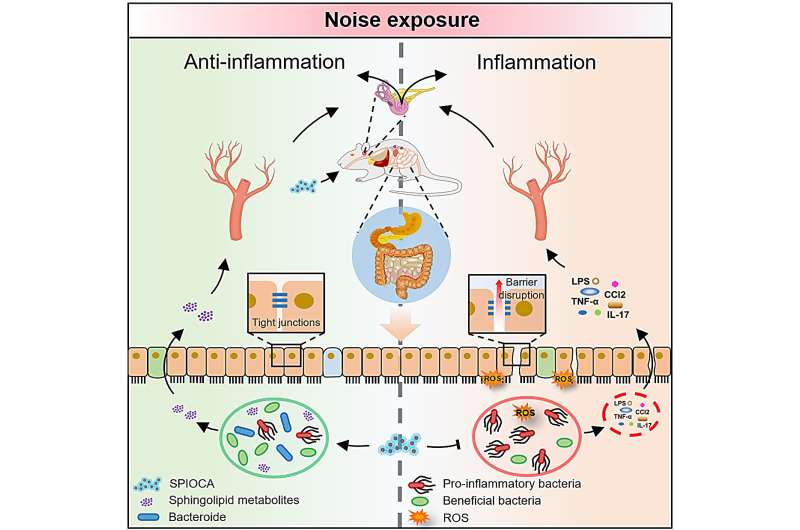This article has been reviewed according to Science X's editorial process and policies. Editors have highlighted the following attributes while ensuring the content's credibility:
fact-checked
trusted source
proofread
Superparamagnetic iron oxide nanoparticle regulates microbiota–gut–inner ear axis for hearing protection

As industrialization and urbanization accelerate, noise-induced hearing loss (NIHL) has become an increasingly prevalent sensorineural hearing disorder. Despite the widespread use of hearing aids and cochlear implants to alleviate some of the challenges posed by hearing loss, these devices offer limited treatment efficacy and cannot reverse or cure damage to the auditory nerves and inner ear structures. Consequently, there is an urgent need to develop novel treatments for NIHL to effectively prevent and repair hearing loss, thereby improving patients' quality of life.
In traditional Chinese medicine, magnetite (Magnetitum) and hematite (Hematitum) have been used for centuries to treat various neurological disorders, including hearing loss. Magnetite is known for its calming, sedative, and hearing restoration effects, while hematite is renowned for its ability to soothe the liver, anchor the spirit, and provide a calming effect. These mineral medicines have been widely applied in clinical practice, accumulating a wealth of experience and case studies.
Inspired by traditional Chinese medicine, modern scientists have begun to explore how to combine the active ingredients of these traditional medicines with modern technology to develop more targeted and effective treatments. The research team used FDA-approved carboxymethyl cellulose (CMC) as a coating agent to develop a pH-responsive superparamagnetic iron oxide nanoparticle assembly (SPIOCA). SPIOCA exhibits excellent biocompatibility and can effectively resist degradation by stomach acid.
The study found that oral administration of SPIOCA can significantly inhibit immune-inflammatory responses in the cochlea, effectively protecting against noise-induced hearing loss and cochlear hair cell loss. This discovery provides new possibilities for treating NIHL.
In their research, the team found that SPIOCA exerts its protective effects by regulating the composition of the gut microbiota. Noise exposure often leads to the proliferation of harmful bacteria, disrupting the balance of the gut microbiota. Oral administration of SPIOCA not only reduces the proliferation of harmful bacteria but also maintains the number of beneficial bacteria, thereby stabilizing the gut microenvironment.
The stability of the gut microbiota is crucial for suppressing intestinal inflammation and oxidative stress responses. SPIOCA protects the integrity of the gut barrier by inhibiting intestinal inflammation and oxidative stress. This process reduces the transport of pro-inflammatory factors into the bloodstream, thereby lowering the risk of systemic inflammatory responses. This protective effect extends to the inner ear, effectively safeguarding auditory function.
Sphingolipids are a class of lipids that play a crucial role in cell signaling and structural stability, and their metabolic pathways are essential for hearing protection. The study also found that SPIOCA can specifically increase the abundance of Bacteroides, a beneficial bacterium in the gut that can produce sphingolipids. By regulating sphingolipid metabolism in the gut-inner ear axis, SPIOCA further enhances its protective effect on hearing.
The findings of this study not only provide a new method for hearing protection but also offer new ideas for treating other microbiota dysbiosis-related diseases. The research was published in the journal National Science Review under the title "Superparamagnetic iron oxide nanoparticle regulates microbiota–gut–inner ear axis for hearing protection."
Professor Ning Gu from Nanjing University, Professor Renjie Chai from Southeast University, and Associate Professor Dongfang Liu from Southeast University are the corresponding authors. Doctoral student Zhanhang Guo from Southeast University and Associate Professor Yunhao Wu from Shandong First Medical University are the co-first authors of the paper.
More information: Zhanhang Guo et al, Superparamagnetic iron oxide nanoparticle regulates microbiota–gut–inner ear axis for hearing protection, National Science Review (2024). DOI: 10.1093/nsr/nwae100



















